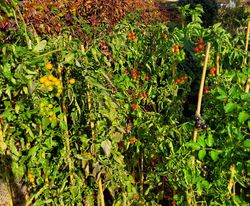Five questions for Lubera® boss Markus Kobelt about tomatoes
Do we really need more tomato varieties?
Of course! This is because the general conditions for growing tomatoes are constantly changing; the needs of customers are changing and, of course, because the host-pathogen interaction is always changing. This means that, especially in resistance breeding with polygenic resistances or tolerances, as we do with tomatoes, resistance must also be continuously expanded and made reliable through breeding.
But something else is crucial: tomatoes are bred primarily for commercial cultivation in tunnels and glasshouses, or in the south, where there is little rain. Our home garden cultivation in the north, in Central Europe, is fundamentally different – and for this we need special varieties, which should also reflect the diversity of the tomato, its known or still undreamt-of possibilities: tomato diversity for the garden, especially for cultivation without weather protection, in the Open Sky® in other words. It should definitely be a thing of the past that, in order to grow tomatoes, you first have to know how to use a drill in order to make a tomato roof...
What are your goals in tomato breeding?
- Resistance to Phytophthora and Alternaria, 70% healthy leaves by the end of September
- As much diversity of shapes, colours, flavours and plant architecture as possible
- Taste, but not only sugar, and also more spiciness, sugar-acid ratio, umami (black varieties)
This means that we and our colleagues in the outdoor tomato breeding programme, from whom we have learnt so much, are only at the beginning: above all, we need to equip other types of growth besides the stake tomatoes with resistance (for example vine tomatoes, compact tomatoes, hanging tomatoes).
Are Open Sky® tomatoes F1 hybrids or open-pollinated varieties?
Open Sky® tomatoes are not F1 hybrids. We select the best individuals from the second generation of crosses and propagate them via tissue culture. The variety selection is made after further cultivation tests with this material. With this procedure we can radically shorten the time to variety. Parallel to vegetative propagation, the inbred lines are further developed for the development of open-pollinated varieties up to the point of possible seed propagation. Currently, however, all of our tomato young plants come from tissue culture.
What is the future of tomato breeding at Lubera®?
We believe that we can develop new varieties in 3 - 5 year cycles. The aim will be to increase the variety of colours and shapes and, above all, to develop new varieties and architectural types for the simplest and least complicated cultivation in the garden.
How will the Open Sky® tomato varieties be distributed?
After last year's trial cultivation in 2021 under the extreme climate conditions of the year, Lubera.com is including the variety series in its range. At the same time, the first young plants are also available for other vegetable plant producers at Lubera Edibles.

